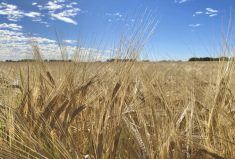As harvest continued late into this fall, Prairie grain buyers continued to sort out what they would pay for this year’s crop.
“Currently, grain company discounts and premiums for grade and protein are variable and changing almost daily as they try to determine what they can pay for these grains, what they will be able to sell them for, and how much time are they going to have to spend blending or drying the grain to meet sales specs,” said Brian Wittal of Pro Com Marketing in Olds, Alta. He expected grade spreads to widen for the lower grades.
Read Also

Agronomists share tips for evaluating new crop products and tech: Pt. 3
With new products, new production practices and new technology converging on the agriculture industry at a frenetic pace in recent…
At mid-October, for instance, the discount from No. 1 to No. 2 CWRS ranged from 10 to 25 cents per bushel, said Jason Labossiere, senior risk management consultant with INTL FCStone. The No. 2 to No. 3 CW discount ranged from 50 cents to $1.22/bu. Meanwhile for durum, the No. 1 to No. 2 CWAD discount averaged 25 cents per bushel. The No. 2 to No. 3 discount ranged from 50 cents to $1.10/bu. and for No. 4 to No. 5 ranged from $1.25 to $2.75/bu.
Labossiere anticipated durum discounts being subject to additional widening as No. 1 to No. 3 CWAD will be needed for exports.
Buyers cautious
Neil Townsend, senior market analyst with FarmLink Marketing Solutions, said grain firms are in no rush to take ownership of lower-quality wheat. “So they’re making farmers absorb the risk on that.”
He said regional quality differences will determine discounts and premiums in different areas across the Prairies. Once buyers have determined the quality available, they can begin offering programs for downgraded product in different areas and blend it at port to produce something better than the component parts.
“Discounts vary depending on the end use for the grain. It is very important that the farmer understands the discount schedules of the grain companies they are selling to,” said Allen Pirness, senior trader with Market Place Commodities in Lethbridge, Alta.
Wittal added that for feed wheat, the discount will be calculated based on the current feed market that day. He advises sending samples to several grain companies, as each firm will offer something different based on their location. Elevators in some regions may be able to offer a better grade or premium if they have more good quality to work with for blending, Wittal said.
Alberta Agriculture’s crop market analyst Neil Blue agreed.
“The best advice I have for farmers is to shop widely among their buyers for the best farm gate prices available for whatever quality of wheat that they do harvest.”
Protein content will also affect discounts and premiums.
Wittal said that in mid-October, grain companies were paying two cents per tenth percentage point of protein between 13.0 and 13.5 per cent and one cent per tenth from 13.6 per cent and higher.
Discounts were wider under 13 per cent — three cents per tenth down to 11 per cent. Wittal expected premiums above 13 per cent to increase later in the crop year.
“Depending on (location), a farmer may get a better price for high-protein 3 CW than a lower-protein 2 CW,” Pirness said. “Those can be local considerations depending on what the elevator is committed to ship versus what is in the area.”
Wittal said a high-protein No. 3 could prove valuable to grain companies with low-protein No. 1 and No. 2 to blend. But he still reckoned the better the grade, the better price a farmer will net in the end, and he’d prefer a low-protein No. 2 over a high-protein No. 3.
“If you are in an area that has all high-protein wheat, you will not get as much of a premium as you would like, and someone with a low-protein No. 2 may get a better return,” Wittal said, noting grain companies can blend it easily.
Sell or hold?
If you were lucky enough to harvest higher grades, should you hold on in hopes of wider premiums later in the year?
“The best price seems to be in the spot market for high-quality stuff,” Pirness said. “It may continue to go higher, but waiting for that without a plan is risky.”
Wittal recommends shopping around to let grain companies know what you have and waiting for offers.
“Then I would lock in my prices sooner than later to protect those premiums they offer. If you think the futures are going to go higher later, then only lock in your basis and spreads, and gamble on locking in the futures later.”
He also advises specifying grades when contracting to lock in the spreads and premiums for those grades and be protected from possible changes.
Townsend said growers who harvested high-quality wheat should look for movement opportunities of a portion sooner than later. “But you don’t want to give it away.”
Blue offers a compromise of committing some for sale and holding some so you have the flexibility of seeing what the market does later.
“That approach might even help to build or strengthen a relationship with a certain buyer or buyers, especially if they’re really eager to take some of that grain right now. Maybe even if it’s in tough or damp condition, a farmer could get a break on the drying cost by committing to deliver some (higher grades).”
Oats and barley
For high-quality oats, Townsend expected another window of opportunity later in the marketing year, as buyers have already swooped in for quite a bit.
“It looks like high-quality oats may be in strong demand again this year,” Blue said. “We’ve seen some premiums offered, and they may even increase as we go further into the crop year if we continue to battle against difficult weather conditions.”
Wittal was more cautious about waiting.
“The oats market is very small, so a quality wreck should push values higher, but you need to be aware of world supplies and not wait too long to sell.”
As for malting barley, Townsend was wary about sitting on supplies. Often what happens is that as the year progresses, more malt barley ends up coming out of the woodwork.
“I would look to advance sales if I had it in the bin and knew it was good. I would use deferred selling points if you don’t want to market it right away. But I would try to get most of that price sooner than later.”
Wittal was also conservative, saying malting barley values could increase, but if buyers can source it elsewhere cheaper, that’ll limit price upside unless there’s a supply shortage somewhere else.
MarketsFarm analyst Bruce Burnett said most lower-grade oats and barley stays in the domestic market, but some export customers will buy feed barley. South Korea is one, and although China might be a question mark, it has imported in the past.
“It’s much like wheat in that prices have to be very competitive with corn in order for these countries to purchase them,” Burnett said.
















